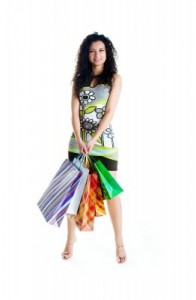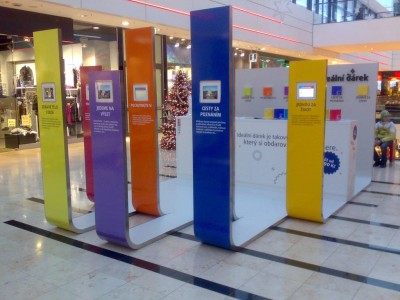Štítky spotřebitelské chování
POPAI: Rozhodnutí o nákupu se děje v místě prodeje více než dříve
10. Kvě
 To že v době recese a stoupající nezaměstnanoti většina lidí šetří, není asi překvapení. V případě nákupu se ale více jak 76% nakupujících rozhoduje až v obchodě. Studie POPAI přináší informace o trendu chování spotřebitele v místě prodeje a to od roku 1965 do součastnosti. Průzkum byl prováděn kombinací klasické dotazovací metody a moderních trackovacích technologií (viz. Kdo se dívá aneb přesné zacílení spotu na reklamních obrazovkách)
To že v době recese a stoupající nezaměstnanoti většina lidí šetří, není asi překvapení. V případě nákupu se ale více jak 76% nakupujících rozhoduje až v obchodě. Studie POPAI přináší informace o trendu chování spotřebitele v místě prodeje a to od roku 1965 do součastnosti. Průzkum byl prováděn kombinací klasické dotazovací metody a moderních trackovacích technologií (viz. Kdo se dívá aneb přesné zacílení spotu na reklamních obrazovkách)
Jak tedy vypadá a hlavně jak se chová nakupují dnes a dříve? Studie přináší pět klíčových zjištění, která by měla být v případě in-store marketingu brána do úvahy. Více studie:
With a prolonged recession, high unemployment, and a persistently challenging economy, the majority of U.S. grocery shoppers are looking to save money where they can. Yet when it comes to making decisions on what to buy more decisions than ever before, 76% to be exact, are being made in-store.
The Point of Purchase Advertising International (POPAI), the global association for the marketing at retail industry, today released findings from its 2012 Shopper Engagement Study. Building upon a long line of major shopper research trend studies, dating back to 1965, POPAI’s 2012 Shopper Engagement Study once again paved the path for in-store research by adding a combination of groundbreaking EEG and eye-tracking technology to attitudinal findings and shopper interviews in-store.
So what does today’s shopper look like compared to the shopper of yesteryear? The study found five key findings that in-store and shopper marketers should note when developing and implementing shopper programs.
Today’s Shopper: Making more decisions in-store than ever before.
Today’s shopper is more empowered than ever before to make educated and responsible buying decisions, but surprisingly it turns out than more shoppers are utilizing in-store marketing and branding cues to make an overwhelming portion of their purchase decisions. Today’s in-store decision rate has reached an all time high of 76%. To determine the in-store decision rate purchases are broken down into four different categories – Specifically Planned, Generally Planned, Substitutes, and Unplanned. The in-store decision rate is calculated by taking the sum of the purchases that fall under Generally Planned, Unplanned, and Substitutes categories.
The in-store decision rate is one of the most reliable measures because it is based upon pre and post shopping interviews — what the shopper anticipated to purchase versus what they actually purchased. Given the uptick in this key metric it is clear that retailers and brands who fail to provide the in-store marketing and education the shopper seeks out risk pushing shoppers into the arms of retailers and brands who are embracing in-store marketing.
If you’re not putting your brand on ‘display’ you’re less likely to put your brand in the shopper’s basket.
From organic labels to premium labels to private labels today’s shopper has more product choices than ever before. If you’re not utilizing in-store marketing to put your product on display you’re likely losing out in the battle at the shelf to get your product into the shoppers basket. The study found that nearly 1 in 6 brand purchases are made when a display with that brand is present in store. The product categories in supermarkets with the highest brand lift were toaster pastries, pickles/relish, dishwashing soap, and pet supplies.
Overall, a clear pattern emerged suggesting that displays in general are best targeted to a core group of loyal, female stock-up shoppers, even when she shows elements of high degree of pre store planning in the form of list making and circular use.
Retailers are not fully maximizing the multitude of opportunities that exist to enhance the in-store experience.
Today’s shopper spends less time but significantly more dollars during his/her shopping trip. Whether it’s using easy to find product displays in secondary locations or working with brand marketers to develop customized in-store display materials to reflect the unique retail environments, retailers have plenty of opportunity to turn their in-store marketing up a notch. It is worth noting that in 1995, 47% of displays were placed in secondary locations. By 2012, this number has risen to 60% as retailers have embraced the notion of cross promoting items and locating displays away from the home aisle.
Compelling creative not only sets apart in-store marketing, but it can turn the subconscious shopper into a conscious buyer.
Today’s shopper faces an insurmountable number of SKU’s from which to choose. While most are unaware at the number of cues and visual information they are processing on a subconscious level one thing is certain — when presented with a compelling and visual display they become engaged and conscious to the value proposition being offered. When asked if they recalled seeing any in-store displays 56% of shoppers indicated that they did recall seeing in-store displays with endcap and free-standing displays being cited most frequently.
Interestingly enough a significant number of eye fixations (13%) were made on in-store displays. While this number may sound low in the field of eye-tracking and neuroscience it is quite high. Moreover, 66% of all observed grabs resulted in a purchase, which underscores the importance of capturing the shoppers’ attention and getting them engaged with the product.
Shoppers who use debit/credit cards are more susceptible to impulse purchases and make more decisions in-store.
Shoppers who choose to use non-cash payment methods find themselves with greater flexibility to spend more than they plan to – and they do. They buy larger quantities and make more unplanned purchases than their cash paying counterparts.
Shoppers fare poorly at accurately predicting how much they are going to spend at the store today. The average shopper misjudges the amount (s)he will spend—either high or low– by 35%. Even when accounting for impulse purchases 57% of shoppers still spend more than they planned. Not surprisingly, shoppers are least able to accurately predict how much they are going to spend on items they do not plan to buy. Those who “overspend on impulse items” do so by more than 200% of what they expected to spend on impulse buys.
“The findings from POPAI’s 2012 Shopper Engagement Study clearly tell us that as in-store and shopper marketing professionals we have some areas for opportunity and improvement,” said Richard Winter, POPAI President. “Even as other emerging mediums and technologies alter the path to purchase landscape this study underscores the importance of planning the in-store experience to win over shoppers where it matters most – the point of purchase.”
To view the complete findings from the topline report of the study, please visit www.popai.com/engage. POPAI will also be releasing supplemental findings from the 2012 Shopper Engagement Study throughout the year online and in-person as part of it’s Engaging Insights Series.
METHODOLOGY
The Shopper Engagement Study is comprised of two concurrently executed research modules. The Core Methodology included pre and post shopping interview formats with 2400 shoppers across the four broad U.S. census regions. The Secondary Module incorporates portable electroencephalography (EEG) equipment, worn by a subset of 210 shoppers while they shop. This is combined with eye tracking to tie shoppers’ physiological responses to exactly what they are looking at, eliminating such issues as recall and denial.
In addition, auditors took inventory of in-store display materials present in each store each morning prior to the start of interviewing. Data included:
· Display Type
· Location
· Placement
· Other variables
· Category and brand the display is advertising
· Static vs. motion
· Product vs. no product
· Whether it is interactive or not
· Whether it has video or audio
Vliv smyslového marketingu na prodejní místo
27. Dub
 „Obchodníci vědí, že existuje spojení mezi atmosférou prodejního místa a výší prodejů. Nepostřehnutelné detaily od osvětlení, designu prodejního místa přes hudbu k vizuální prezentaci, to vše hraje roli při zvyšování kultury prodeje, zvyšování návštěvnosti prodejního místa a, v zásadě vzato, při zvyšování prodeje,“ uvedl Aleš Štibinger, který se ve své prezentaci věnoval vlivu atmosféry místa prodeje na výši prodeje a spotřebitelské chování.
„Obchodníci vědí, že existuje spojení mezi atmosférou prodejního místa a výší prodejů. Nepostřehnutelné detaily od osvětlení, designu prodejního místa přes hudbu k vizuální prezentaci, to vše hraje roli při zvyšování kultury prodeje, zvyšování návštěvnosti prodejního místa a, v zásadě vzato, při zvyšování prodeje,“ uvedl Aleš Štibinger, který se ve své prezentaci věnoval vlivu atmosféry místa prodeje na výši prodeje a spotřebitelské chování.
Byl proveden výzkum, který poskytuje nový pohled na to, jakým způsobem reaguje nakupující na jednotlivé prvky atmosféry prodejního místa (vědomě i podvědomě) a také na míru souvislosti mezi atmosférou prodejního místa a výší prodejů.
Studie se zabývá mnoha aspekty atmosféry prodejního místa z obou stran „pultu“. První část studie měří přístup spotřebitele k atmosféře prodejního místa, prozkoumává, které specifické části ovlivňují spotřebitele, aby utratil více peněz či času v místě prodeje. Druhá část studie je rozsáhlý výzkum přístupu obchodníků a jejich postupy při pokusech optimalizovat prožitek z nakupování tak, aby zvýšili návštěvnost obchodu, zákazníkovu loajalitu a samozřejmě také prodeje.
Spotřebitelé byli měřeni v několika kategoriích: věk, příjem domácnosti, četnost nákupů a pohlaví. Obchodníci byli měřeni podle velikosti řetězce, velikosti obchodu a typu obchodu.
Výzkum spotřebitele zahrnoval telefonické rozhovory se 450 domácnostmi v USA. Polovina dotázaných byly ženy, druhou polovinu představovali muži. Výzkum obchodníků je výsledkem telefonických dotazníků pro výkonné řídící pracovníky přímo zapojené do rozhodování o koncepci prodejního místa. Dotázáno bylo 91 různých řetězců.
Výsledky průzkumu jsou shrnuty do vyčerpávajícího přehledu přístupů a strategií, které dnes ovlivňují „výkon“ prodejního místa. Je potřeba si také uvědomit, že prodejní místo není jen typický obchod ať už s potravinami, módou nebo domácími potřebami, ale také jakékoliv místo prodeje služeb, jako je např. pošta, kadeřnictví nebo wellness centrum.
zdroj: popai.cz
Nejnovější komentáře